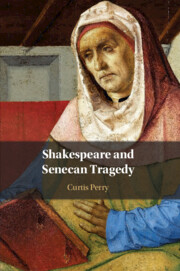Book contents
- Shakespeare and Senecan Tragedy
- Shakespeare and Senecan Tragedy
- Copyright page
- Contents
- Acknowledgments
- Note on Texts
- Chapter 1 Shakespeare and the Resources of Senecan Tragedy
- Chapter 2 Richard III as Senecan History
- Chapter 3 Seneca and the Modernity of Hamlet
- Chapter 4 Seneca and the Antisocial in King Lear
- Chapter 5 Republican Coriolanus and Imperial Seneca
- Chapter 6 Seneca, Titus, and Imperial Globalization
- Chapter 7 Senecan Othello and the Republic of Venice
- Bibliography
- Index
Chapter 2 - Richard III as Senecan History
Published online by Cambridge University Press: 06 October 2020
- Shakespeare and Senecan Tragedy
- Shakespeare and Senecan Tragedy
- Copyright page
- Contents
- Acknowledgments
- Note on Texts
- Chapter 1 Shakespeare and the Resources of Senecan Tragedy
- Chapter 2 Richard III as Senecan History
- Chapter 3 Seneca and the Modernity of Hamlet
- Chapter 4 Seneca and the Antisocial in King Lear
- Chapter 5 Republican Coriolanus and Imperial Seneca
- Chapter 6 Seneca, Titus, and Imperial Globalization
- Chapter 7 Senecan Othello and the Republic of Venice
- Bibliography
- Index
Summary
Richard III, which has been described as Shakespeare’s most Senecanesque play, inhabits a middle ground between tragedy and history play. Because it focuses on the rise and fall of its title character, it is sometimes thought of as a precursor for later tragedies like Macbeth. Such readings emphasize the flamboyant, villainous agency of the play’s central antihero. When Richard III is read as a chronicle history play, however, it can be seen as being about how its central character’s monstrosity is overtaken by providential history. This chapter argues that the resulting ambiguity of perspective is built into the play’s Senecan inheritance. The first section examines paradoxes concerning human agency and temporal cause and effect in Senecan tragedy, and it looks at plays – like Octavia, Ecerinis, and The Spanish Tragedy – that are imitative of that tradition. Then the chapter reads Richard III as a sophisticated, Senecan examination of the dialectic between self-assertion and external predetermination. This Senecan dialectic underpins aspects of Richard’s character that have been read brilliantly in recent criticism via highly theorized postmodern ideas about character and psychology: here Seneca is a silent partner in the creation of one of Shakespeare’s most presciently modern-seeming characters.
- Type
- Chapter
- Information
- Shakespeare and Senecan Tragedy , pp. 37 - 72Publisher: Cambridge University PressPrint publication year: 2020



